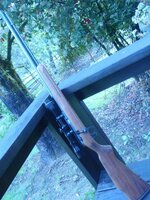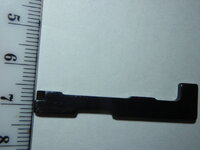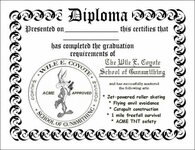Silver Supporter
Bronze Supporter
- Messages
- 4,214
- Reactions
- 6,920
I have been in search of a Marlin bolt .22 Magnum for about 2 years, and learned pretty quickly that decent ones come at a high premium. One beautiful specimen at a gun show was priced at nearly 700 dollars. I saw two at a gun show in March, and they were a bit rough, but salvageable, and they were priced at nearly 400. I almost offered on one, but decided to wait.
About two months ago, I visited a gun shop new to me for the purposes of a transfer. It was a very small shop, mostly AR15 oriented (not my general cup of tea), but they did have a modest used gun rack. Nothing of interest there to me.
The transfer was delayed, requiring my return about 10 days later. A significant drive to get there, so the plan was to grab the transferred/cleared gun and get out. I strolled past the used rack twice, glancing at what I had seen before. (The proprietor was busy on the phone, and I waved him with "No hurry.") I scanned the rack a third time, and saw bright blue and walnut. Proprietor off the phone, I asked permission to inspect further, and the first thing I saw was the loading slot on the tube was big. A Marlin Model 883 .22 Magnum in great shape! "Yeah, just took that in on trade yesterday", said the Proprietor (confirming I had NOT overlooked it on the first visit).
We settled on a price that made me want to get out of there even quicker. I guess AR store guys aren't up on Marlin Fever. "Stole it with a receipt!"
LESSON ONE:
ALWAYS check the used rack. Even if you think you know what is there from a previous visit.
At home and cleaning the Marlin up, I was even happier. Blue and wood in near-new condition, sight hood, the whole enchilada. I wondered at a gun that had been built in 1989 and had obviously seen VERY little use.
Optics choice was relatively easy with criteria being light weight and full performance. A Leupold 3x-9x Compact A.O. EFR was chosen. My graveyard had multiple rimfire ring choices, and I installed a couple of versions on the gun, but they just did not match the streamlined quality of the rifle and the scope. I ordered a set of Leupold rimfire rings.

LESSON TWO:
Leupold, on their premier rimfire rings, overlooked the very real possibility that the dovetail rings might be attached to a round-receiver gun. There is no clearance under the pedestal that will allow the clamp to reach to the dovetail on a round receiver (or at least not this one).
The obstacle was surmounted by judicious use of a Dremel tool, creating a concave curve to the underside of the ring pedestal to allow for the convex top of the round receiver. I was quite nervous butchering a high-dollar, brand new set of rings, but the process went slowly and carefully, and cold blue finished it off (even if the milled portion was hidden anyway).
The trigger was rather horrendous (over 6 lbs), so prior to shooting, I ordered and installed a Rifle Basix upgraded trigger. What a delightful difference!
Scope mounted, trigger installed, multiple brands of ammo accompanied the Marlin to the bench. I was pretty excited. Shouldn't have been.
Misfires. At the rate of 20-30 percent. Pin strikes showed somewhat light, but I thought adequate. Changing ammo did not change the malfunction.
LESSON THREE:
NEVER significantly modify (such as the firing mechanism) a factory gun without testing function first.
It should quickly be noted that the new trigger was NOT the cause of the malfunction, but had I shot the rifle before installing the trigger, I would have never considered it as a possible culprit, and would not have been required to swap back to the factory trigger to continue the investigation.
Thankfully, the factory trigger did the rifle no favors upon re-installation, and the misfires continued at the same rate.
I believed at this point I had discovered why the gun wasn't used much: Because it wouldn't shoot much.
I went full-on shotgun approach and ordered not only a new firing pin, but a striker spring as well. Cleaned and light oiled everything. Polished stuff. Arrival of parts showed the replacement striker spring to be much more powerful than original. This HAD to be it!
Nope. Failure rate only slightly improved (and I had to do testing with both firing pins and both springs back and forth). Things became tedious, discouraging, and not without some expense: each mechanical change required another testing session. A passing grade could only be achieved with two full magazines (24 rounds) fired without malfunction.
Early in the misadventure, I did a cursory Webbernet search, and DID find some forums where owners had experienced this same malfunction, most with no concrete solutions.
Now I went to the Oracle with more time to spend and found a brief reference to firing pin design being an area to examine toward a solution.
LESSON FOUR:
Rimfire firing pin impact areas (or at least this one) are machined at two different depths: one section of course smacks the rim of the case. The other half of this impact area is left without the sharp bevel for ignition. It also protrudes a very small bit further than the case-impact portion. This larger, flat portion is meant to impact the barrel face for the purposes of allowing an occasional dry-fire that does not damage the portion that actually causes ignition.

Probably common knowledge to throngs of others, but it was news to me.
A small diamond file relieved this flat portion a bit, allowing the firing pin (also now driven by a more powerful spring) to smack the livin' hell outta that rim.
The rifle now functions perfectly, and I'm not only happy with it, I'm always happy when I learn something (or am reminded of lessons I already knew).
About two months ago, I visited a gun shop new to me for the purposes of a transfer. It was a very small shop, mostly AR15 oriented (not my general cup of tea), but they did have a modest used gun rack. Nothing of interest there to me.
The transfer was delayed, requiring my return about 10 days later. A significant drive to get there, so the plan was to grab the transferred/cleared gun and get out. I strolled past the used rack twice, glancing at what I had seen before. (The proprietor was busy on the phone, and I waved him with "No hurry.") I scanned the rack a third time, and saw bright blue and walnut. Proprietor off the phone, I asked permission to inspect further, and the first thing I saw was the loading slot on the tube was big. A Marlin Model 883 .22 Magnum in great shape! "Yeah, just took that in on trade yesterday", said the Proprietor (confirming I had NOT overlooked it on the first visit).
We settled on a price that made me want to get out of there even quicker. I guess AR store guys aren't up on Marlin Fever. "Stole it with a receipt!"
LESSON ONE:
ALWAYS check the used rack. Even if you think you know what is there from a previous visit.
At home and cleaning the Marlin up, I was even happier. Blue and wood in near-new condition, sight hood, the whole enchilada. I wondered at a gun that had been built in 1989 and had obviously seen VERY little use.
Optics choice was relatively easy with criteria being light weight and full performance. A Leupold 3x-9x Compact A.O. EFR was chosen. My graveyard had multiple rimfire ring choices, and I installed a couple of versions on the gun, but they just did not match the streamlined quality of the rifle and the scope. I ordered a set of Leupold rimfire rings.

LESSON TWO:
Leupold, on their premier rimfire rings, overlooked the very real possibility that the dovetail rings might be attached to a round-receiver gun. There is no clearance under the pedestal that will allow the clamp to reach to the dovetail on a round receiver (or at least not this one).
The obstacle was surmounted by judicious use of a Dremel tool, creating a concave curve to the underside of the ring pedestal to allow for the convex top of the round receiver. I was quite nervous butchering a high-dollar, brand new set of rings, but the process went slowly and carefully, and cold blue finished it off (even if the milled portion was hidden anyway).
The trigger was rather horrendous (over 6 lbs), so prior to shooting, I ordered and installed a Rifle Basix upgraded trigger. What a delightful difference!
Scope mounted, trigger installed, multiple brands of ammo accompanied the Marlin to the bench. I was pretty excited. Shouldn't have been.
Misfires. At the rate of 20-30 percent. Pin strikes showed somewhat light, but I thought adequate. Changing ammo did not change the malfunction.
LESSON THREE:
NEVER significantly modify (such as the firing mechanism) a factory gun without testing function first.
It should quickly be noted that the new trigger was NOT the cause of the malfunction, but had I shot the rifle before installing the trigger, I would have never considered it as a possible culprit, and would not have been required to swap back to the factory trigger to continue the investigation.
Thankfully, the factory trigger did the rifle no favors upon re-installation, and the misfires continued at the same rate.
I believed at this point I had discovered why the gun wasn't used much: Because it wouldn't shoot much.
I went full-on shotgun approach and ordered not only a new firing pin, but a striker spring as well. Cleaned and light oiled everything. Polished stuff. Arrival of parts showed the replacement striker spring to be much more powerful than original. This HAD to be it!
Nope. Failure rate only slightly improved (and I had to do testing with both firing pins and both springs back and forth). Things became tedious, discouraging, and not without some expense: each mechanical change required another testing session. A passing grade could only be achieved with two full magazines (24 rounds) fired without malfunction.
Early in the misadventure, I did a cursory Webbernet search, and DID find some forums where owners had experienced this same malfunction, most with no concrete solutions.
Now I went to the Oracle with more time to spend and found a brief reference to firing pin design being an area to examine toward a solution.
LESSON FOUR:
Rimfire firing pin impact areas (or at least this one) are machined at two different depths: one section of course smacks the rim of the case. The other half of this impact area is left without the sharp bevel for ignition. It also protrudes a very small bit further than the case-impact portion. This larger, flat portion is meant to impact the barrel face for the purposes of allowing an occasional dry-fire that does not damage the portion that actually causes ignition.

Probably common knowledge to throngs of others, but it was news to me.
A small diamond file relieved this flat portion a bit, allowing the firing pin (also now driven by a more powerful spring) to smack the livin' hell outta that rim.
The rifle now functions perfectly, and I'm not only happy with it, I'm always happy when I learn something (or am reminded of lessons I already knew).













